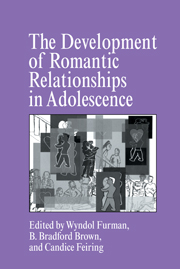Book contents
- Frontmatter
- Contents
- Contributors
- Foreword
- Acknowledgments
- 1 Missing the Love Boat: Why Researchers Have Shied Away from Adolescent Romance
- Part I Processes in Romantic Relationships
- 2 The Emotions of Romantic Relationships: Do They Wreak Havoc on Adolescents?
- 3 The Nature and Functions of Social Exchange in Adolescent Romantic Relationships
- 4 Cognitive Representations of Adolescent Romantic Relationships
- 5 Romantic and Sexual Relationship Development During Adolescence
- Part II Individual Differences in Romantic Relationships
- Part III The Social Context of Romantic Relationships
- Part IV Conclusion
- Author Index
- Subject Index
5 - Romantic and Sexual Relationship Development During Adolescence
Published online by Cambridge University Press: 05 October 2014
- Frontmatter
- Contents
- Contributors
- Foreword
- Acknowledgments
- 1 Missing the Love Boat: Why Researchers Have Shied Away from Adolescent Romance
- Part I Processes in Romantic Relationships
- 2 The Emotions of Romantic Relationships: Do They Wreak Havoc on Adolescents?
- 3 The Nature and Functions of Social Exchange in Adolescent Romantic Relationships
- 4 Cognitive Representations of Adolescent Romantic Relationships
- 5 Romantic and Sexual Relationship Development During Adolescence
- Part II Individual Differences in Romantic Relationships
- Part III The Social Context of Romantic Relationships
- Part IV Conclusion
- Author Index
- Subject Index
Summary
Romantic and sexual relationships have a unique intensity during the second decade of life. Childhood is widely perceived as a time of relative quiescence compared to the romantic and sexual exuberance of youth. Romantic feelings and sexual behavior are not completely dormant during childhood, but adolescence is qualitatively different; by the early or middle teens, the vast majority of adolescents become preoccupied with romantic feelings (Medora, Goldstein, & Von der Hellen, 1994; Savin-Williams & Berndt, 1990) and begin a lifetime trajectory of overt sexual experiences (Miller, Christopherson, & King, 1993). One study that monitored the daily subjective states of adolescents found that the strongest association between puberty and emotional experience is the specific feeling of being in love (Richards & Larson, 1993).
How is the development of romantic feelings and sexual behaviors related to one another? We conjecture that almost all children and early adolescents have romantic ideas (“crushes”) about persons with whom they have no sexual contact. We further conjecture that romantic thoughts and interactions typically precede sexual involvement in the process of normal adolescent development. However, through choice or coercion, some children and adolescents have “body-centered” sexual experiences devoid of romantic meanings. There is a growing awareness that the development of intimate relationships can be profoundly affected by coercive sexual experiences.
- Type
- Chapter
- Information
- The Development of Romantic Relationships in Adolescence , pp. 99 - 122Publisher: Cambridge University PressPrint publication year: 1999
- 49
- Cited by

